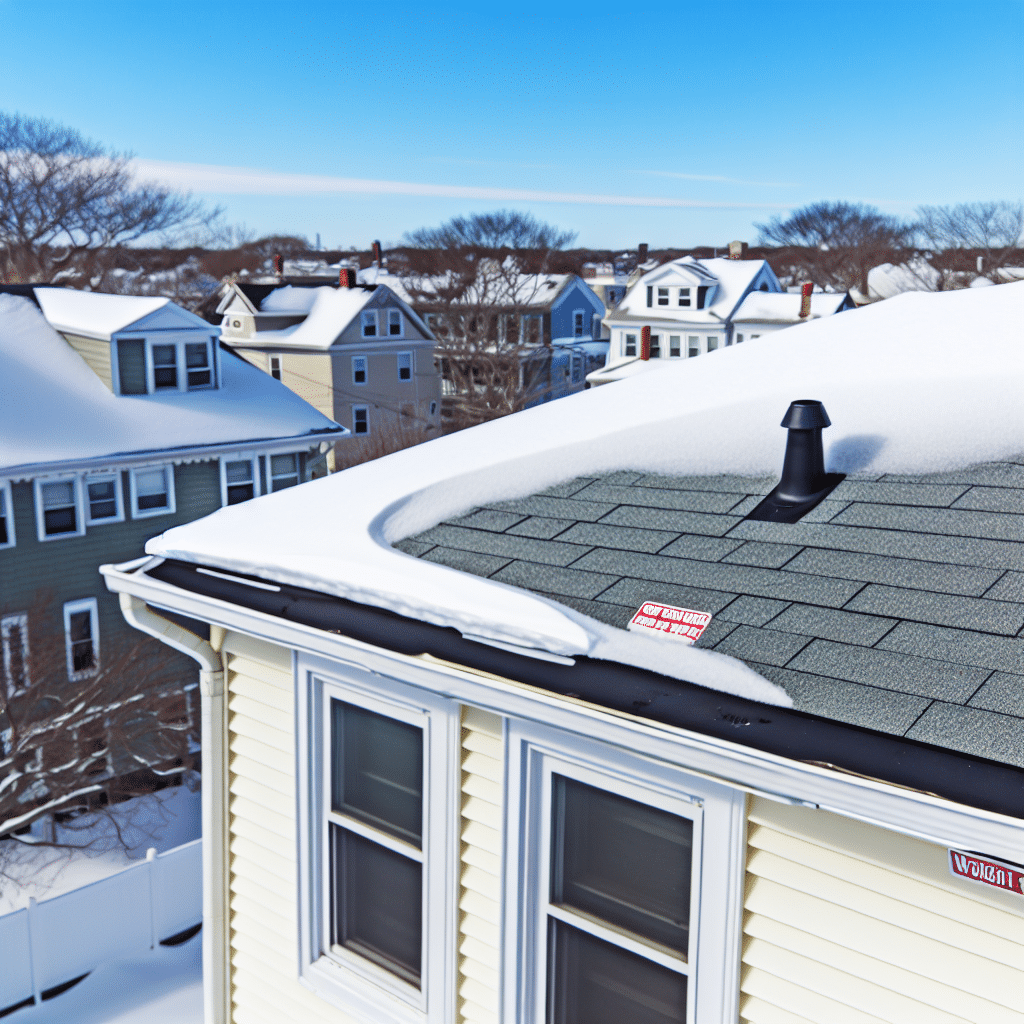Understanding Roof Weight Limits
The roof above us serves as the first line of defense against the elements, but its capability to protect is bound by how much weight it can hold. For homeowners in Providence, RI, where the spring can still carry the weight of winter’s snow, this knowledge isn’t just technical—it’s essential. In a region where the weather is as unpredictable as the lottery, the question isn’t just a matter of curiosity; it’s about safety and stability. Homes are built to last, yet their endurance relies significantly on our awareness and vigilance regarding the loads our roofs bear. That’s why understanding the weight capacity of your roof is not just wise, it’s imperative for the longevity of your home and the safety of your family.
Imagine a scenario, typical yet often overlooked, where the attic becomes a storage unit, or during the holiday season, where decorations outdo the previous year. Each box, each decoration adds weight to the structure designed to shield you from the outside world, but there’s a limit. And it’s not just about the immediate load; think of the environmental stresses too, as even a beautiful blanket of snow adds a silent pressure. The risks of ignoring these factors can lead to dire consequences—strained structures, potential collapse, and financial burdens from reparations. These risks aren’t meant to scare but to enlighten the importance of expert evaluation and to heed guidelines in place for a reason.
Seasonal weather phenomena in Providence can turn roofs into unwitting resting grounds for snow, a picturesque scene with a deceptive weight. In reference to the professional standards outlined in the National Building Code, correctly gauging the load is pivotal—a task trusted to those who understand the intricate balance between structure and nature. It’s not just about what meets the eye; it’s the integrity of what lies beneath the shingles and tiles. This is why an expert’s role in assessing your roof’s carrying capacity is indispensable. It’s about equipping homes to withstand Providence’s unique climate challenges, ensuring that when the snow falls or the storage accumulates, the roof remains unphased, protecting everything underneath.
Decoding the Technicalities of Roof Capacity
When we consider the resilience of a roof, technical knowledge becomes pivotal. Building codes in Rhode Island meticulously outline the minimum requirements for structural integrity, ensuring that each roof is constructed to endure not just the items we place upon it, but also the stress exerted by environmental elements like snow and rain. These codes are rooted in a blend of science and experience, reflecting years of architectural evolution and disaster response learning. For the layperson, these guidelines might seem perplexing, but they are the unsung blueprints that guarantee the safety of our households and businesses. The specifics might be complex, but adhering to them means your roof’s load capacity is one less thing to worry about.
One common concern many homeowners have is the impact of snow accumulation during the tail end of winter. The aesthetic appeal of a winter wonderland can quickly turn into a hazard when the weight of the white blanket surpasses the load-bearing capacity of a roof. This is where expertise in roof maintenance and structure evaluation becomes indispensable—a specialized assessment can highlight vulnerabilities and recommend fortifications to help your roof maintain its integrity. By consulting with trusted professionals like those at Rinaldi Roofing, homeowners can convert these concerns into actionable insights, preserving the longevity of their homes.
But the scope of assessing roof load capacity isn’t just a winter chore. Houses evolve; they undergo renovations, and sometimes new installations like solar panels or air conditioning units add weight to your roof. In times like this, it is vital to reassess the weight your roof can safely bear. A rooftop might seem like a convenient place to store rarely used items or extra materials, but this convenience should never compromise safety. Ensuring that your roof can carry the burdens of both your needs and nature’s demands is just another step toward a home that is both beautiful and secure.
Securing Peace of Mind Through Roof Vigilance
The peace of mind that comes from knowing your roof is well-prepared to handle various weights—including that of unexpected spring snow—is invaluable. It’s a key component of home ownership that’s often taken for granted, yet it’s critically important for safeguarding your living space. Providence residents are no strangers to the whims of nature, and preparedness can make all the difference when it counts. Through regular inspections and understanding the intricacies of your roof’s capacity, you take a proactive stance in home maintenance. This not only helps prevent potential collapse but also ensures your home remains a haven against the elements.
Often overlooked is the importance of emergency scenarios and how well a roof can withstand additional dynamic loads during such times. For instance, during severe weather events, the need to quickly secure a tarp over damaged sections might arise. This adds temporary weight, which even if minor, must be factored into overall load calculations. Acknowledgment of such eventualities is what distinguishes the vigilant homeowner from the unprepared. The wisdom in consulting with specialists from Rinaldi Roofing cannot be overstated; they not only provide emergency services but can also advise on the necessary preparations for such unforeseen weights.
Ultimately, understanding the weight capacities of your roof is to appreciate the engineering marvel that is your home. It’s not merely about handling the here-and-now loads but being attuned to the age and condition of the roof, and how those factors may alter its weight tolerance over time. Regular evaluations, conducted by roofing experts, are an investment in the life and integrity of your property. These professionals can discern the nuances of your specific roof, advising on any necessary modifications or reinforcements. As Providence continues to experience its unique weather patterns, let your roof remain steadfast above you, a testament to conscientious ownership and expert craftsmanship.
Insights From The Experts
Tip 1:
Regularly monitor your roof’s condition, especially after intense weather events. Early detection of any sagging or damage can prevent excessive weight strain that compromises its structural integrity.
Tip 2:
Understand your local building codes regarding roof load capacity. Compliance ensures your roof’s construction meets the necessary standards for supporting both live and dead loads.
Tip 3:
Consider the addition of reinforcement if you’re planning to install heavier materials or add equipment to your roof. Consulting with an experienced structural engineer can provide guidance on safe load limits.
Tip 4:
Be proactive with snow and ice removal. In regions with heavy winter weather, the accumulation of snow can add unexpected weight to your roof and may exceed its designed capacity.
Tip 5:
Schedule annual inspections with licensed roofing professionals. These experts can assess your roof’s ability to withstand various weights and offer solutions to enhance its load-bearing capabilities.
Addressing Common Concerns
How should overflow drains be designed to handle potential heavy rainfall and avoid water intrusion?
To efficiently manage heavy rainfall, overflow drains should be adequately sized, strategically placed, and routinely cleared of debris. They must be designed to quickly channel away excess water, preventing any chance of water backing up and intruding into the property.
Can the existing structure withstand the additional load of snow accumulation during winter months?
An existing structure’s ability to endure the weight of snow accumulation relies on its adherence to regional building codes and the state of its maintenance—professional assessment is essential for a definitive answer.
What precautions should be taken during installation to ensure long-term durability and safety?
During installation, using quality materials and following best practices, such as proper fastening techniques and weight distribution, can ensure the durability and safety of the structure.
Are there specific materials that fare better under the weight of heavy snow?
Yes, materials like metal roofing are known for their durability and ability to shed snow more efficiently, which can reduce the weight load on your roof during winter.
How often should my roof be inspected to ensure it can handle the prescribed weight limits?
Roofs should be professionally inspected at least once a year, but more frequently if severe weather events occur or if you’re planning any significant changes to the structure or use of your roof.



